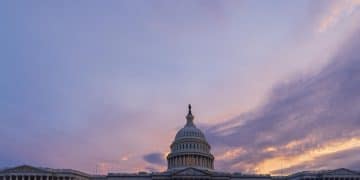Campaign Finance Reform 2025: Impact on US Political Spending

The Impact of Campaign Finance Reform on Political Spending in 2025 involves analyzing how new regulations or changes to existing laws governing political donations and expenditures will reshape the financial landscape of US elections, affecting campaign strategies and potentially influencing electoral outcomes.
Understanding the impact of campaign finance reform on political spending in 2025 is crucial for anyone following US politics, as it reveals how new laws could reshape election campaigns. Will reforms truly level the playing field, or will money still dominate political discourse? Let’s delve into the potential changes.
Understanding Campaign Finance Reform
Campaign finance reform refers to the set of laws and regulations designed to govern and control political contributions and spending in elections. These reforms aim to promote transparency, prevent corruption, and ensure fair and equitable participation in the democratic process.
The need for reform often arises from concerns about the influence of money in politics, the potential for wealthy donors to sway policy decisions, and the overall health of democracy. What are the main components of campaign finance regulations and how might they change?
Key Components of Campaign Finance Regulations
Campaign finance regulations typically cover various aspects of political funding. Understanding these building blocks is crucial.
- Contribution Limits: Caps on the amount of money individuals and organizations can donate to political campaigns and committees.
- Disclosure Requirements: Rules mandating the reporting of campaign contributions and expenditures to enhance transparency.
- Independent Expenditures: Regulations addressing spending by groups not formally affiliated with a candidate’s campaign.
- Public Financing: Systems providing government funds to candidates who meet certain criteria, aiming to reduce reliance on private donations.
Changes in these areas could significantly affect political spending in the 2025 election cycle. Imagine if contribution limits are drastically reduced; how would campaigns adapt?

The upcoming years are pivotal, as lawmakers and citizens debate the necessity and scope of these reforms, aiming to balance free speech rights with the need for a fair electoral process. What specific proposals are on the table right now?
Potential Legislative Changes in 2025
Looking ahead to 2025, several legislative changes could significantly impact campaign finance. These changes are often driven by evolving political landscapes and ongoing debates about fairness and transparency in elections. These proposals are crucial.
Key areas under consideration include revisions to the Federal Election Campaign Act (FECA), adjustments to regulations on Super PACs, and potential constitutional amendments aimed at clarifying the role of money in politics. Consider the impact:
Revising the Federal Election Campaign Act (FECA)
Legislators might propose amendments to FECA to address loopholes and modernize regulations for the digital age.
Adjustments to Regulations on Super PACs
The rise of Super PACs and their influence on elections could lead to tighter regulations on independent expenditures, aiming to limit their impact.
- Increased Disclosure: Requiring Super PACs to disclose donors more frequently and comprehensively.
- Restrictions on Coordination: Strengthening rules to prevent coordination between Super PACs and candidate campaigns.
- Limitations on Spending: Imposing caps on the total amount Super PACs can spend in an election cycle.
The potential for constitutional amendments also looms, especially concerning the First Amendment’s interpretation related to campaign finance. These changes aren’t just theoretical; they have real-world consequences for political campaigns and their strategies.
These potential changes show how the legal landscape may evolve, shaping campaign finance in the future. What strategies will campaigns adopt to navigate these potential reforms?
Campaign Strategies in a Reformed Landscape
If campaign finance reforms are enacted, political campaigns will need to adapt their fundraising and spending strategies. The impact of these reforms will be profound, altering how candidates reach voters and manage their resources.
With restricted access to large donations and limitations on independent expenditures, campaigns could shift their focus to grassroots fundraising, digital engagement, and more targeted advertising strategies. How will these techniques alter the game?
Grassroots Fundraising
Campaigns might emphasize small-dollar donations from individual supporters to offset the loss of large contributions. This approach requires building a strong base of dedicated volunteers and using online platforms to solicit contributions.
Digital Engagement
With traditional advertising methods potentially limited, campaigns will likely invest more in online advertising, social media marketing, and targeted digital communication to reach voters directly.

- Micro-Targeting: Using data analytics to identify and target specific voter segments with tailored messages.
- Social Media Campaigns: Leveraging platforms like Facebook, Twitter, and Instagram to mobilize supporters and disseminate information.
- Online Fundraising: Creating online platforms for easy and secure donations from supporters.
The strategies discussed will not only influence the tactics employed by each campaign, but will be the determining factor on who wins and loses the election. What unintended consequences might arise from these reforms?
Unintended Consequences of Reform Efforts
While campaign finance reforms aim to improve transparency and fairness, they can also lead to unintended consequences. These unintended effects can sometimes undermine the very goals the reforms were meant to achieve.
For example, stricter regulations on traditional campaign finance channels might drive more money into less regulated areas, such as dark money groups or online advertising platforms, where disclosure requirements are weaker. Consider these areas:
Shift to Dark Money Groups
If traditional campaign finance channels become too restricted, donors might shift their support to dark money groups, which are not required to disclose their donors. This could increase the opacity of political spending, making it harder to track the source of funds.
Increased Reliance on Soft Money
Campaigns might seek to raise soft money, which refers to funds raised outside the regulated campaign finance system, to support activities that indirectly benefit a candidate. This could lead to a resurgence of unregulated spending in elections.
Assessing these consequences can prove a complicated endeavor. To what degree can these effects influence political participation and voter turnout?
Influence on Political Participation and Voter Turnout
Campaign finance reforms can have varying effects on political participation and voter turnout. Some reforms might encourage greater participation, while others could inadvertently suppress it.
For instance, reforms that promote small-dollar donations and grassroots fundraising could empower ordinary citizens to participate more actively in campaigns, leading to increased engagement and higher voter turnout. However, stricter regulations that limit campaign spending could reduce the reach of political advertising, potentially demobilizing some voters.
- Empowering Small Donors: Reforms that encourage small-dollar donations can make individuals feel more invested in the political process.
- Reducing the Influence of Wealthy Donors: Reforms that limit the influence of wealthy donors can create a more level playing field, encouraging greater participation from ordinary citizens.
- Limiting Campaign Advertising: Stricter regulations that limit campaign spending can reduce the amount of political advertising, potentially demobilizing some voters.
The impact on voter turnout can be complex. However, one thing is clear: campaign finance reforms can play a significant role in shaping the dynamics of American elections.
Ultimately, the effects of finance reforms on participation and turnout should be carefully considered to determine if the reforms are actually benefitting the country.
The Role of Technology and Digital Platforms
Technology and digital platforms play an increasingly important role in campaign finance and political spending. Online fundraising, social media advertising, and data analytics have transformed the way campaigns operate and engage with voters.
The rise of digital platforms offers new opportunities for campaigns to reach wider audiences at lower costs, but it also raises concerns about transparency, data privacy, and the spread of misinformation. The intersection of technology and campaign finance will be a key battleground in the years to come. Let’s consider how:
Online Fundraising
Digital platforms have made it easier for campaigns to solicit donations from individuals across the country. Online fundraising tools allow campaigns to reach a wider audience and process contributions quickly and efficiently.
Social Media Advertising
Social media platforms have become powerful advertising channels for political campaigns. With targeted advertising, campaigns can reach specific voter segments with tailored messages, maximizing the impact of their spending.
- Data Analytics: Campaigns use data analytics to identify and target specific voter segments with tailored messages, maximizing the impact of their spending.
- Transparency Concerns: The use of digital platforms raises concerns about transparency, as it can be difficult to track the source of online advertising and the flow of digital money.
- Misinformation: Social media platforms can be used to spread misinformation and propaganda, which can influence voters’ perceptions and decisions.
As technology continues to evolve, campaign finance regulations will need to adapt to address challenges and ensure fairness and transparency in the digital age. If trends continue, what might American elections look like for the next decade?
Future Trends in Campaign Finance
Looking ahead, several trends are likely to shape the future of campaign finance and political spending. These trends include the continued growth of online fundraising, the increasing influence of social media, and the rise of artificial intelligence (AI) in campaign strategy.
As these trends evolve, lawmakers and regulators will need to grapple with new challenges and opportunities, adapt existing regulations, and develop innovative approaches. Campaign finance in 2025 and beyond will look significantly different from previous election cycles. Let’s consider the future:
The Growth of Online Fundraising
Online fundraising is expected to continue its growth trajectory, driven by the increasing popularity of digital platforms and the ease of donating online. This trend could empower grassroots movements and level the playing field for candidates.
The Influence of Social Media
Social media platforms will likely remain a dominant force in political communication and advertising. Campaigns will continue to invest heavily in social media marketing and targeting to reach voters.
With these trends in mind, it is important for people to understand the issues behind campaign finance reform and political spending.
Key PointBrief Description
💰 Impact of Reform
Examines how changes affect political donations.
🗳️ Campaign Strategies
Adapting fundraising and voter outreach approaches.
⚖️ Unintended Consequences
Potential negative effects of campaign finance reform.
📱 Role of Technology
The influences of online campaigns and social media.
[Frequently Asked Questions]
What is campaign finance reform?
▼
Campaign finance reform refers to laws and regulations that govern political contributions and spending in elections, aiming to promote fairness and transparency.
Why is campaign finance reform needed?
▼
It’s needed to reduce the influence of wealthy donors and prevent corruption, ensuring a more level playing field for all candidates.
What are the key components of campaign finance regulations?
▼
Key components include contribution limits, disclosure requirements, independent expenditure rules, and public financing options.
How might campaigns adapt to new finance rules?
▼
Campaigns may shift to grassroots fundraising, enhance digital engagement, and target advertising strategies to reach voters efficiently.
What unintended consequences could reform efforts have?
▼
Stricter regulations might drive money into less regulated areas like “dark money” groups, increasing financial opaqueness in elections.
Conclusion
In summary, the impact of campaign finance reform on political spending in 2025 promises to be a transformative force, reshaping campaign strategies and potentially altering the dynamics of American elections as we know them. Understanding these potential shifts is crucial for anyone interested in the future of US politics.
Read more content





